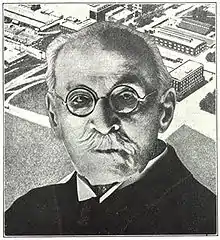Frederick Walton
Frederick Edward Walton (13 March 1834[1] – 16 May 1928),[2] was an English manufacturer and inventor whose invention of Linoleum in Chiswick[3] was patented in 1863.[4] He also invented Lincrusta in 1877.
Frederick Walton | |
|---|---|
 | |
| Born | Frederick Edward Walton 13 March 1834 Halifax, West Yorkshire, England |
| Died | 16 May 1928 (aged 94) |
| Occupation(s) | Inventor, manufacturer, businessman |
| Known for | Inventing Linoleum and Lincrusta Founder of Waltons and Sons |
| Family | James Walton (father) |
Early life
Walton was born in 1834, near Halifax. His father James Walton was a successful inventor and business owner from Haughton Dale near Manchester, where he owned the Haughton Dale Mill, which supplied wire for James's successful carding business.[5] Frederick was educated at Horton School, in Bradford and at the Wakefield Proprietary School.[6]
Waltons and Sons
In 1855, Frederick joined his father James and brother William in the family wire card-making business of Walton and Sons, in Haughton Dale. He spent much of his time working on new techniques for the business. In 1856, he was granted his first patent for wire brushes with ornamental backings. In 1857, he discovered how to solidify linseed oil, which was to lead to his most famous invention. However he also disagreed with his father about the value of his experimentation. Later in 1857, they dissolved the partnership and Frederick moved to Hammersmith, where he set up his own company to continue his work.[6]
Invention of Linoleum
In 1860, he established an experimental factory in Chiswick where he worked on oxidisation of linseed oil, for which he was granted a patent in 1860.[4] He experimented with the oxidized oil as a replacement for rubber. He discovered that combining the oil with cork and colouring agents produced a useful material for floor covering,[6] and in 1863 patented this new material.[4] Walton called this new cloth "linoleum".[3] He moved his factory to Staines, and in 1864, formed the Linoleum Manufacturing Company[7] which, by 1869, was exporting to Europe and the United States.[8]
Expansion to America
In the 1870s, Walton partnered with carpet manufacturer John Crossley to form the American Linoleum Company. They set up a factory at Linoleumville, New York to manufacture linoleum. Walton spent two years in America setting up the factory and starting the business, before returning to the United Kingdom. The America company was highly successful and profitable.[6]
Patents
Walton obtained further patents for processes related to the production of linoleum. In 1863, he patented a method of passing sheets of coloured linoleum through rollers to emboss a pattern on them. In 1882, he patented machinery to make inlaid mosaic floor coverings. He also invented a number of related products, most notably Lincrusta, an embossed wall-covering based on linoleum, launched in 1877.[3] In all he obtained over 100 patents.[6]
Cwmllecoediog
In 1868, Walton moved to the Cwmllecoediog Estate near Aberangell, which was owned by his father. In 1870, he built a new house there, Plas Cwmllecoediog, and in 1883 he gave land and funds to build a school in the village. In 1886, he partnered with quarry manager Edward Hurst Davies to purchased and develop Maesygamfa slate quarry. They ran it together until the partnership was dissolved in 1900.[9]
Death
Walton died in May 1928, aged 94.
Personal life
In 1867, Walton married Alice Scruby.[10] They had four children:
- Olive Mary Walton. Born 1871.[11] Author and Photographer. Married Herbert Vivian in 1897.
- Frederick James Walton, born 1877.[12]
- Clarice Walton, born 1879.[12]
- Violet Walton.[13]
Walton was an avid collector of art, and also painted himself. His son-in-law Herbert Vivian said that Walton "bought many expensive paintings and painted many excellent ones himself".[14]
Books
- Company, Frederick Walton and (1881). Lincrusta. The Sunbury wall decoration. LCCN unk82056986.
- Walton, Frederick (1925). The infancy and development of linoleum floorcloth.
References
- Coleman, William B. (1934). "Frederick Walton: Centenary of the Birth of the Inventor of Linoleum". Chemical & Engineering News. 12 (7): 119–128. doi:10.1021/cen-v012n007.p119 (inactive 1 August 2023). Retrieved 28 February 2014.
{{cite journal}}: CS1 maint: DOI inactive as of August 2023 (link) - Today in Science History. Retrieved 28 February 2014
- Jones, M.W. (21 Nov 1918). The history and manufacture of floorcloth and linoleum. Society of Chemical Industry.
- "The Floorcloth and Linoleum Industry". Scottish Bankers Magazine. 5. 1913.
- "The Bishop of Manchester on Church Work and Disestablishment". Manchester Courier and Lancashire General Advertiser. 27 March 1876.
- Leading Men of London: a collection of biographical sketches, with portraits. London: British Biographical Co. 1895. pp. 344–345.
- "Scientific and Useful". Age (Melbourne, Vic. : 1854 - 1954). 1865-07-24. p. 7.
- Powell, Jane; Linda Svendsen (2003). Linoleum. Gibbs Smith. ISBN 978-1-58685-303-7.
- Quine, Dan (December 2022). The Hendre Ddu Tramway: Blue Stones and Green Trees. Lightmoor Press. ISBN 9781915069153.
- "Marriages". Morning Post. 22 March 1867.
- "Frederick Walton's Household Members", United States census, 1871; Isleworth; roll 118, page 24,.
- "Frederick Walton's Household Members", United States census, 1881; Twickenham; roll 92, page 20,.
- "News". Cambrian News. 26 August 1887.
- Vivian, Herbert (1923). Myself not least, being the personal reminiscences of "X.". New York: H. Holt and Company.